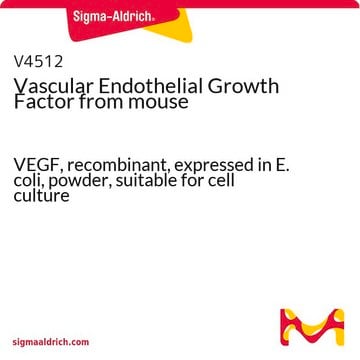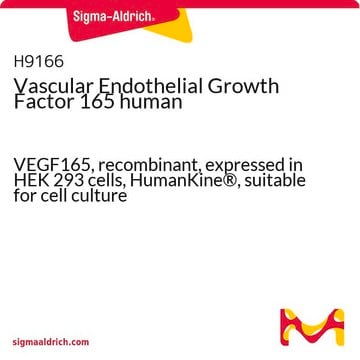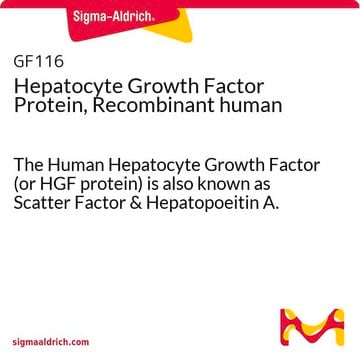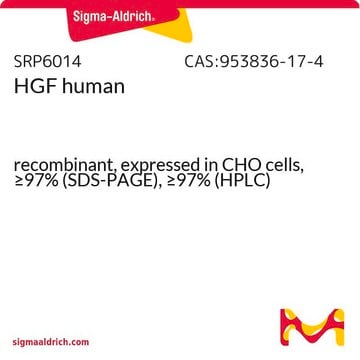01-185
VEGF Protein, Human recombinant
The human recombinant VEGF Protein is available in a 10 µg format.
Sinónimos:
VEGF Growth Factor
About This Item
Productos recomendados
biological source
human
Quality Level
recombinant
expressed in baculovirus infected Sf9 cells
form
liquid
manufacturer/tradename
Upstate®
technique(s)
cell culture | mammalian: suitable
input
sample type neural stem cell(s)
sample type hematopoietic stem cell(s)
sample type mesenchymal stem cell(s)
NCBI accession no.
UniProt accession no.
shipped in
dry ice
Gene Information
human ... VEGFA(7422)
General description
Application
1. Prior to use in this assay, maintain HUVE cells in F-12K medium supplemented with 10% (v/v) FBS, 1% penicillin-streptomycin-glutamine, 0.1 mg/ml heparin and 0.05 mg/ml endothelial cell growth supplement (ECGS).
2. For assay of VEGF, subculture HUVE cells into a 96-well plate at a density of 4,000 cells per well in the growth medium over night.
3. Add VEGF to a final concentration range of 0.2, 0.4, 0.8, 1.6, 3.2, 6.2, 12.5, 25 and 50ng/ml. Add VEGF diluent to one set of wells as the negative control.
4. Four days later, add 20ul of Promega Substrate Cell Titer 96 Aqueous One Solution Reagent to each well.
5. Incubate at 37C for 2 hrs and read at OD 490nm.
Quality
Cell Proliferation Assay: The biological activity of this lot of VEGF was determined by its mitogenic activity on human umbilical vein endothelial cells (HUVEC) with an ED50 of about 1.0 ng/mL. Results may vary depending on the cell line used. VEGF will also stimulate endothelial cells from other species.
Physical form
Storage and Stability
This product is acid stable. Dilute in either 0.1% TFA or 4mM HCl, containing 25ug BSA per ug VEGF to maintain stability. Reducing reagents (such as dithiothrietol or 2-mercaptoethanol) inhibit VEGF activity.
Legal Information
Disclaimer
Storage Class
12 - Non Combustible Liquids
wgk_germany
nwg
flash_point_f
Not applicable
flash_point_c
Not applicable
Certificados de análisis (COA)
Busque Certificados de análisis (COA) introduciendo el número de lote del producto. Los números de lote se encuentran en la etiqueta del producto después de las palabras «Lot» o «Batch»
¿Ya tiene este producto?
Encuentre la documentación para los productos que ha comprado recientemente en la Biblioteca de documentos.
Nuestro equipo de científicos tiene experiencia en todas las áreas de investigación: Ciencias de la vida, Ciencia de los materiales, Síntesis química, Cromatografía, Analítica y muchas otras.
Póngase en contacto con el Servicio técnico







